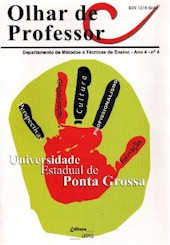Licenciatura e Formação de Professor Tendências e Perspectivas
Main Article Content
Abstract
Este texto é uma separata do segundo capítulo da dissertação de mestrado da autora, o qual se constitui em um estudo avaliativo sobre o Curso de Licenciatura em Educação Física da Universidade Estadual de Ponta Grossa. Neste recorte, centramos as discussões em um dos pontos mais polêmicos do Ensino Superior – a formação do profissional Professor nas Licenciaturas –, ponto desconsiderado por muitos, mas tido como o centro das discussões para outros profissionais Assim, este trabalho encaminha as leituras para as novas diretrizes curriculares nacionais para a formação inicial de professores da educação básica, em cursos de nível superior. Aborda de forma objetiva concepções de diferentes autores sobre a temática Licenciatura - Formação de Professor e Currículo intermediado pelos apontamentos do Relatório DELORS. O trabalho não apresenta conclusões finais, mas vislumbra momentos de mudanças curriculares nas Licenciaturas, especificamente em Educação Física. Consta ainda, ao final, a bibliografia que deu suporte a presente investigação.
Metrics
Article Details
Authors who publish in this journal agree with the following terms:
a) Authors keep the copyrights and concede the right of its first publication to the magazine. The work piece must be simultaneously licensed on the Creative Commons Attribution License which allows the paper sharing, and preserves both the author identity and the right of first publication to this magazine.
b) Authors are authorized to assume additional contracts separately, to not-exclusively distribution of the paper version published in this magazine (e.g.: publish in institutional repository or as a book chapter), with the author identity recognition and its first publication in this magazine.
c) Authors are permitted and stimulated to publish and distribute their papers online (e.g.: in institutional repository or on their personal webpage), considering it can generate productive alterations, as well as increase the impact and the quotations of the published paper.
d) This journal provides public access to all its content, as this allows a greater visibility and reach of published articles and reviews. For more information on this approach, visit the Public Knowledge Project, a project that developed this system to improve the academic and public quality of the research, distributing OJS as well as other software to support the publication system of public access to academic sources.
e) The names and e-mail addresses on this site will be used exclusively for the purposes of the journal and are not available for other purposes.

This work is licensed under a Creative Commons Attribution 4.0 International License.

